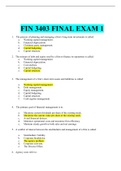FIN 3403 FINAL EXAM 1
1.The process of planning and managing a firm’s long-term investments is called:
a.Working capital management.
b.Financial depreciation.
c.Christmas party management.
d.Capital budgeting.
e.Capital structure.
2.The mixture of debt and equity used by a firm to finance its operations is called:
a.Working capital management.
b.Financial depreciation.
c.Cost analysis.
d.Capital budgeting.
e.Capital structure.
3.The management of a firm’s short-term assets and liabilities is called:
a.Working capital management.
b.Debt management.
c.Equity management.
d.Capital budgeting.
e.Capital structure.
f.Cash register management.
4.The primary goal of financial management is to:
a.Maximize current dividends per share of the existing stock.
b.Maximize the current value per share of the existing stock.
c.Avoid financial distress.
d.Minimize operational costs and maximize firm efficiency.
e.Maintain steady growth in both sales and net earnings.
5.A conflict of interest between the stockholders and management of a firm is called:
a.Stockholders’ liability.
b.Corporate breakdown.
c.The agency problem.
d.Corporate activism.
e.The Divorce Effect.
6.Agency costs refer to: a.the total dividends paid to stockholders over the lifetime of a firm.
b.the costs that result from default and bankruptcy of a firm.
c.corporate income subject to double taxation.
d.the costs of any conflicts of interest between stockholders and management.
e.the total interest paid to creditors over the lifetime of the firm.
7.The original sale of securities by governments and corporations to the general public occurs in the:
a.primary market.
b.secondary market.
c.private placement market.
d.proprietary market.
e.liquidation market.
8.Which one of the following business types is best suited to raising large amounts of capital?
a.sole proprietorship
b.limited liability company
c.corporation
d.general partnership
e.limited partnership
9.Net working capital is defined as:
a.total liabilities minus shareholders’ equity.
b.current liabilities minus shareholders’ equity.
c.fixed assets minus long-term liabilities.
d.total assets minus total liabilities.
e.current assets minus current liabilities.
10.Financial leverage refers to the:
a.amount of debt used in a firm’s capital structure.
b.ratio of retained earnings to shareholders’ equity.
c.ratio of paid-in surplus to shareholders’ equity.
d.ratio of cost-of-goods-sold to total sales.
e.amount of receivables present in the firm’s asset structure.
11.Dr. Small’s Tranquility Spa has $300 in inventory, $600 in fixed assets, $250 in accounts receivables,
$100 in accounts payable, and $600 in cash. What is the amount of the current assets?
CA
a.$500Inv=300
b.$550AR=250
c.$600Cash=600
d.$1,150Toal=1150
e.$1,200 12.The Schwartz Disco Emporium has total assets of $900, fixed assets of $500, long-term debt of $500, and short-term debt of $200. What is the amount of net working capital? NWC=CA-CL
a.$0current asset=400 LD=500
b.$100fixed asset=500 SD=200
c.$200total asset=900total debt=700
d.$300(TA=TD+TE) 900=700+2000 400-200=200
e.$400
13.Mireya’s Secret Boutique has sales of $640,000 and costs of $480,000. Interest expense is $40,000 and depreciation is $60,000. The tax rate is 16%. What is the net income? Sales-COGS=EBDIT
a.$20,400 $640,000-$480,000=$160,000-$60,000=$100,000-$40,000=$60,000-$9,600=$50,400
b.$39,600 $60,000x.16=$9600
c.$50,400
d.$79,600
e.$99,600
14.Given the tax rates as shown, what are the taxes due for a firm with taxable income of $126,500? Taxable Income Tax Rate
$0 -50,00015%
50,001 -75,00025%
75,001 -100,00034%
100,001 -335,00039%
a.$22,250
b.$32,250
c.$32,585
d.$34,585
e.$42,585
15.For the above problem what is the marginal tax rate?
a.21.38 percent
b.15.00 percent
c.25.00 percent
d.34.00 percent
e.39.00 percent
16.At the beginning of the year, Dr. Greenberg’s Medical Services has current assets of $380 and current liabilities of $210. At the end of the year, the current assets are $410 and the current liabilities are $250.
What is the change in net working capital?CA-CL (change)Ending- beginning
a.-$30Beginning yearCA:380CL:210
b.-$10End yearCA:410 CL:250 c.$0 410-380=30250-210=40
d.$12 30-40= -10
e.$32
17.The financial ratio measured as net income divided by sales is known as the firm’s:
a.profit margin. NI/sales= profit margin
b.return on assets.
c.return on equity.
d.asset turnover.
e.earnings before interest and taxes.




